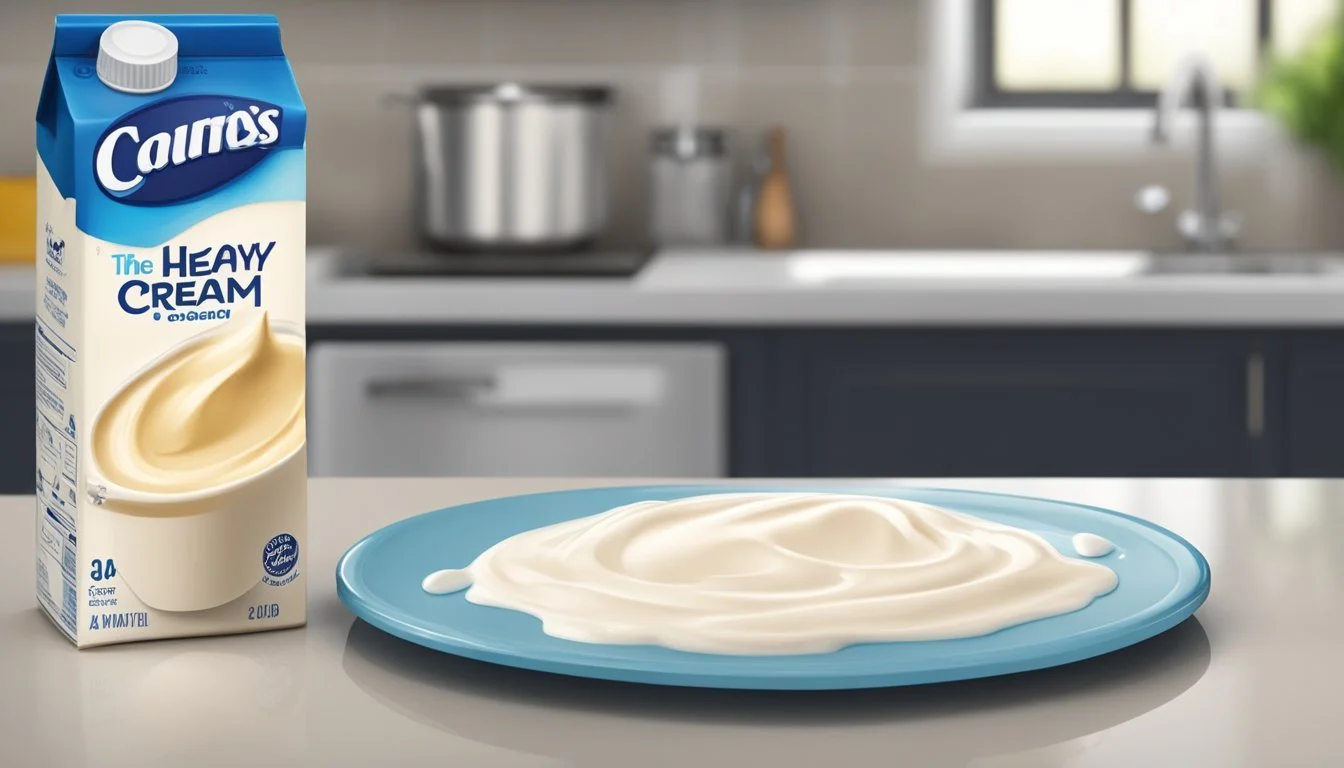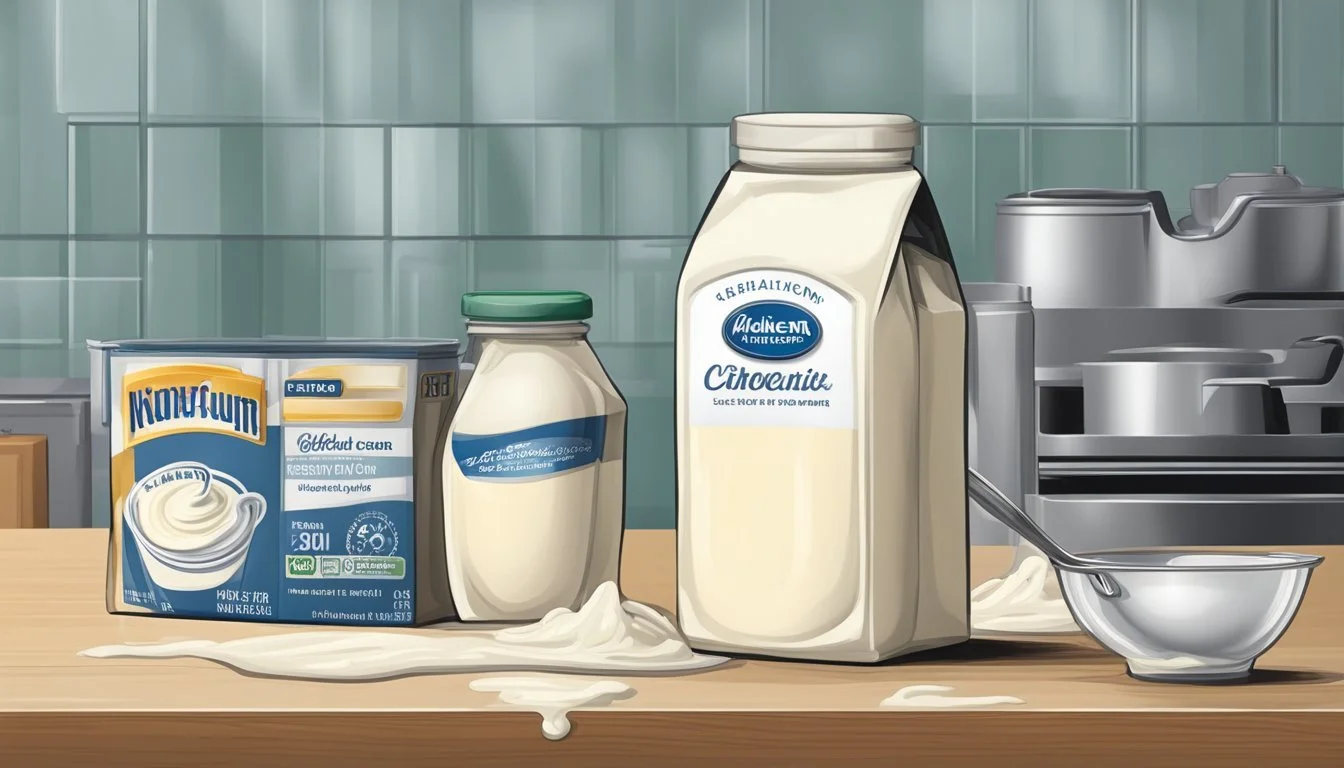Does Heavy Cream Go Bad?
Shelf Life and Spoilage Signs
Heavy cream, a staple in many kitchens, does indeed go bad. Unopened heavy cream often remains good for several weeks past its expiration date if stored properly. Once opened, its shelf life extends up to about a month when consistently refrigerated. Keeping it cold is key to maintaining its quality.
Identifying spoiled heavy cream relies heavily on your senses. It should be thick, smooth, and white or off-white in color without clumps. Signs of spoilage include a sour smell, mold, or separation of liquid. One should be cautious, as consuming expired cream could lead to digestive issues.
For those unsure whether their heavy cream remains fresh, it’s best to err on the side of caution. When in doubt, it's safer to discard any cream that appears questionable to avoid potential health risks. Understanding these simple checks can help home cooks ensure they are using only the best quality ingredients.
Understanding Heavy Cream
Heavy cream, a staple in many kitchens, is appreciated for its rich texture and versatility. It is key in making dishes like sauces, soups, and desserts creamier and more luxurious.
Composition and Types
Heavy cream, also known as heavy whipping cream, contains a high fat content, typically between 36% and 40% milk fat. This distinguishes it from other types of cream, like light cream or half-and-half, which have lower fat percentages. The high fat content gives heavy cream its thick, smooth consistency and ability to whip into whipped cream.
There are two main types: pasteurized and ultra-pasteurized. Pasteurized heavy cream has a fresher taste but a shorter shelf life, while ultra-pasteurized cream is heated to higher temperatures to extend its shelf life, making it slightly less fresh in flavor.
Heavy Cream vs. Other Dairy Products
Heavy cream is often compared to whipping cream, sour cream, and milk due to their usage in similar recipes. Whipping cream has a lower fat content, around 30-35%, making it less thick and rich compared to heavy cream.
Sour cream, on the other hand, is fermented and has a tangy flavor, making it unsuitable as a direct substitute for heavy cream in recipes requiring a neutral taste. Milk and half-and-half, with their significantly lower fat contents, lack the richness and ability to form peaks like heavy cream. In baking and cooking, the choice of dairy product affects the texture and flavor of the dish significantly.
Shelf Life and Spoilage
Heavy cream can last for varying periods depending on whether it is opened or unopened. Attention to signs of spoilage ensures it is safe for consumption.
Expiration Date and Usability
Heavy cream has a notable shelf life due to its high-fat content and refrigeration. Unopened heavy cream can remain usable for several weeks past its expiration date or sell-by date as long as it is stored properly. Once opened, it generally lasts up to a week but should ideally be used within 2 to 3 days for best quality.
Storing the cream consistently at a cool refrigerator temperature is crucial. Avoid leaving it out on the counter for extended periods. Any noticeable change in color, texture or odor indicates the need for disposal.
Signs of Spoiled Cream
Detecting spoiled cream involves using sight, smell, and taste. Key signs include:
Sour Smell: A rancid or sour odor suggests spoilage.
Discoloration: Any deviation from its creamy white color to yellow or grey indicates it is no longer good.
Mold: Presence of mold spots is an obvious sign the cream is expired.
Lumps and Grainy Texture: Fresh heavy cream should be smooth. If it appears lumpy or grainy, it has soured.
Taste: A tart or off-taste is a clear indication that the cream is spoiled.
Always discard cream that shows these signs to ensure safety and quality in your recipes.
Storage Practices
Properly storing heavy cream is essential to ensure safety and maintain quality. Knowing the correct storage conditions and methods can extend its shelf life and prevent spoilage.
Proper Storage Conditions
Heavy cream should always be stored in a refrigerator at or below 40°F (4°C). An unopened container can stay fresh for up to a month if kept under these conditions.
Once opened, the container should be kept sealed and placed in the coldest part of the fridge, not in the door. The fridge door experiences temperature fluctuations, which can accelerate spoilage. Properly storing heavy cream involves using an airtight container if the original packaging is not resealable. Never leave heavy cream out at room temperature for more than 2 hours, as this can promote bacterial growth.
Extending Shelf Life
To extend the shelf life of heavy cream, consider freezing it. Freeze heavy cream by pouring it into an airtight container, leaving some space at the top as it will expand. Heavy cream can be frozen for up to 3-4 months. When ready to use, thaw it in the refrigerator and stir well before using.
Label the container with the date of freezing to keep track. For short-term use, ensure it is kept properly sealed and cold. Additionally, minimizing exposure to air by keeping the container tightly closed helps reduce the risk of spoilage. Always check for signs of spoilage such as an off odor or visible mold before consuming.
Usage and Cooking with Heavy Cream
Heavy cream is a versatile ingredient commonly used in various recipes. It can enhance the flavor, texture, and richness of dishes, making it indispensable in both savory and sweet cooking. Different substitutes are available for those who need alternatives.
Incorporating Into Recipes
Heavy cream adds richness to soups, sauces, and desserts. In soups, a splash of heavy cream can provide a silky texture and depth of flavor. For sauces, it combines excellently with ingredients like garlic, cheese, or wine, creating creamy bases for dishes such as Alfredo pasta.
When it comes to baking, heavy cream can give a tender crumb to cakes and richness to pie fillings. It is also ideal for desserts like custards, puddings, and chocolate ganache. In making whipped cream, heavy cream is whipped until it forms stiff peaks and can be sweetened or flavored to suit different tastes.
In coffee, a dash of heavy cream can enhance the creaminess and body of the beverage, providing a luxurious alternative to regular milk. When using heavy cream, it is essential to keep an eye on cooking times and temperatures to avoid curdling or separation, especially in high-heat recipes.
Alternatives and Substitutes
For those avoiding dairy or seeking lighter options, several substitutes can mimic heavy cream's properties. Sour cream or plain yogurt can be used in equal parts for soups and sauces, albeit with a tangier taste. Coconut cream is another excellent non-dairy substitute, especially in desserts and baking.
A mixture of milk and butter can stand in for heavy cream; combine ¾ cup of milk with ⅓ cup of melted butter to match the consistency of one cup of heavy cream. Evaporated milk is another handy substitute, though it may offer a slightly different flavor.
When seeking to avoid high-fat content, half-and-half or whole milk can sometimes replace heavy cream in recipes that do not require whipping. These substitutes work best in coffee, pancakes, or light sauces where a less creamy texture is acceptable. Using the appropriate substitute depends on the desired outcome and recipe requirements.
Health and Safety Considerations
When handling heavy cream, it is crucial to understand the potential risks of consuming spoiled cream and the best practices for safe handling. Awareness of these factors can help prevent foodborne illnesses and maintain the quality of dairy products.
Risks of Spoiled Heavy Cream
Spoiled heavy cream poses serious health risks. Bacteria such as Listeria and E. coli can proliferate in dairy products, leading to food poisoning.
Symptoms of consuming spoiled cream include nausea, vomiting, and diarrhea.
Watch for signs of spoilage, such as a sour flavor, discoloration, mold, or separation, when assessing the quality of heavy cream.
Using clean utensils and equipment when handling heavy cream can minimize the risk of contamination.
Leftovers stored improperly can develop harmful bacteria, making it important to refrigerate or freeze cream swiftly if not used immediately.
Safe Handling Measures
Proper storage is key to preventing spoilage. Unopened heavy cream should be stored in the refrigerator below 40°F (4°C) and can last up to two weeks past the expiration date.
Once opened, it should be used within a week.
When using heavy cream, transfer the amount needed to a clean bowl rather than pouring directly from the container. This prevents contamination.
Ensure that whisks, utensils, and containers are sanitised before use to avoid introducing bacteria.
Never leave heavy cream out at room temperature (above 40°F) for more than two hours. Prompt refrigeration after use can help maintain its quality and safety.
Applying these measures can significantly reduce the risk of foodborne illness.
Creative Ways to Use Leftover Heavy Cream
There are many delicious and practical ways to use leftover heavy cream that prevent waste and enhance the richness of your dishes. Cream can be incorporated into a variety of recipes, from savory meals to sweet desserts and even household staples.
Transforming Leftover Cream
Whipping heavy cream for an extended period can result in homemade butter. Simply use a stand mixer or hand whisk and beat the cream until the butterfat separates from the buttermilk. Strain the buttermilk and rinse the butter under cold water. This freshly made butter can be used in cooking or spread on bread.
2. Making Ice Cream
Heavy cream serves as the base for many homemade ice cream recipes. Mixing it with sugar, vanilla extract, and your favorite flavors, then freezing the mixture, can yield creamy, rich ice cream. No ice cream maker is required; just freeze and periodically stir the mixture to prevent ice crystals from forming.
3. Creamy Sauces and Soups
Adding heavy cream to soups and sauces enhances their texture and flavor. For instance, incorporating cream into tomato soup creates a rich bisque, and adding it to pasta sauces results in a silky, smooth texture. Heavy cream can elevate a basic vegetable soup or pasta dish to gourmet levels.
4. Whipped Cream Topping
Whip the heavy cream with a bit of sugar and vanilla extract to produce a light, fluffy topping perfect for desserts like pies, cakes, and hot chocolate. Homemade whipped cream is fresh and free from preservatives, making it a delicious alternative to store-bought varieties.
5. Baking and Desserts
Heavy cream can be used in various baked goods and desserts. It adds richness to scones, muffins, and cakes. In pastries such as éclairs and tarts, cream can be used to make luscious custards and fillings. Incorporating it into your favorite dessert recipes brings a richer, creamier texture.





